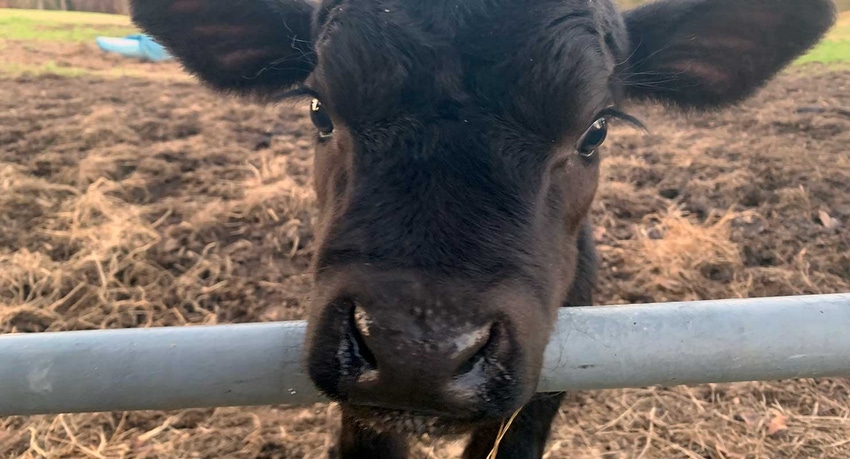
Only in Alabama can December humidity create an opportunity for you to work up a sweat and shiver simultaneously. It was one of those nights when Rachel texted me on my way home from work just after sundown about a first-calf heifer added to the watch list.
“022 may be going into labor. I’ll return in a couple of hours to check.”
I offered to monitor and update until her return. She then noted, “If you go in the pen, Bruce was a little playful with a white body entering at night. You can give him a few pellets if need be.”
Bruce was the most recent SimAngus herd bull addition, named after Bruce Wayne, aka Batman. My 3.5 year-old nephew J.B.’s decision.
Armed with a headlamp and a bucket of pellets for Bruce, I entered the pasture pen every 30 minutes for a status check. A water bag appeared at 7:15 p.m. She was standing with said water bag at 7:45 p.m. with great interest from Bruce. By 8:30 p.m., the whole shooting match, including a live calf and her uterus, were lying on the ground next to her.
I called Rachel with the news, and she and Brant began the process of loading both toddlers and supplies for addressing a uterine prolapse.
I pulled the bull calf from the placenta making sure he wasn’t too full of fluid to breathe. A forced cough or two and he was all clear. The heat was rapidly rising from his steamy body, and he began to shiver. Given Bruce’s playful nature (and the presence of another bull on the to-be-sold list), I didn’t want to leave the calf unattended so I began to wipe him down with what hay I could pull from the nearby round bale.
Soon Rachel and the crew arrived. She tossed a beach towel my way for additional clean up, and I did my best to both wipe him dry and keep him warm. The most effective method was to simply hug him to transfer my own body heat his way.
Naturally the cow was still in shock. Though all it took to stimulate a response was one epidural needle attempt. She shot up and started doing laps. Multiple buckets of feed and several gallons of ATV fuel later, Rachel and Brant had her in the chute for treatment. If you’ve ever been witness to a 120-pound woman placing a 50-pound bovine uterus carefully back into its origin position and then stitching the entry/exodus portal back together, then you’ve seen the miracle that occurs when skill and determination are at their peak.
This process took a couple of hours. In the meantime, my job was simple. Still in recovery from a torn rotator cuff, I got off easy. All I had to do was remain with the calf until it was time for some kind of “first meal” effort. I heard J.B. screaming from the back seat of the Duramax. She had left both boys in their car seats with entertainment (dirty toys and a “Thomas the Train” video) while she was performing surgery. Brant soon came to J.B.’s rescue and walked him down the hill to where the calf and I were cuddled up.
Wiping back wet tears, J.B. walked slowly up to the calf and began to stroke his head.
“Why were you crying, buddy?” I asked.
“I had to go potty,” he said.
My little buddy had recently mastered the art, though location still presents a challenge. Rachel said the barnyard was one thing but dropping trousers in Cracker Barrel was less humorous.
After determining that the calf wouldn’t be making the trek uphill to the working pens without assistance, Brant left to secure transport. With the ATV unresponsive (clearly done for the night), Brant backed the Duramax down the hill, and we loaded everyone up for the nursing attempt.
After a couple of violent kicks from the new mom while still in the chute and a wobbly newborn who wasn’t sure about his legs just yet, Rachel opted instead for some powdered “first milk” via the bottle. When that didn’t pan out, a feeding tube did the job.
“He’s thirsty,” J.B. said as he watched from across the fence while the milk slowly left the bag. “Can I pet him?”
If there’s one thing I have learned in my many blessed years on the ranch, it’s that there is always time to stop and pet a baby calf.
After sufficient good nights were said and hay beds were made, the rescue team departed to leave the recovering patient and new addition in peace.
Fortunately, the next morning revealed that the stitches were still in place. Unfortunately, the pair did not bond, as is often the case with first-calf heifers and traumatic deliveries.
We therefore have our first bottle calf of the season. J.B. has yet to name him. The silver lining—both J.B. and I can pet him any time we want.
Bearden is a biologist with the Geological Survey of Alabama. She writes for Farm Press about the exploits on her family's ranch in Alabama.
About the Author(s)
You May Also Like




